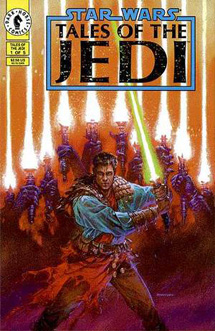For the sake of simplicity, “Star Wars” stories can be divided into four eras. The classic trilogy era started with the movie “Star Wars” (1977), the post-“Return of the Jedi” era started in earnest with the book “Heir to the Empire” (1991) and the prequel era started in earnest with the movie “The Phantom Menace” (1999). That leaves the ancient era, which started with the comic book “Tales of the Jedi” (1993). The first “TOTJ” series, with Onderon as its main location, is ripe for the flashback treatment due to the planet being the site of the current “Clone Wars” arc.
Today, so many tales of ancient Jedi Knights and Sith Lords have been told that it’s easy to forget how groundbreaking the five-issue series by writer Tom Veitch and artist Chris Gossett was. I remember picking up the first issue and being surprised by how much of it seemed familiar: Although it takes place 4,000 years prior to “A New Hope,” we see Jedi Masters and apprentices, lightsabers, lightspeed travel and a galactic government — the Old Republic. I had kind of assumed that the stories would tell the very earliest days of the Jedi (something we’re now seeing with “Dawn of the Jedi,” set 25,000 years before “A New Hope”), but rather, “TOTJ” takes place in the heyday of the Jedi — and Sith, for that matter. When you consider space travel and other everyday tech in the “Star Wars” universe, it makes sense that the history of civilization in the GFFA would cover a much longer span of time than human history on Earth.
At the same time, “TOTJ” feels historic, and it’s Gossett’s drawings more so than the narrative that provide this fascinatingly ancient feel. The ships and architecture — such as Onderon’s walled city of Iziz and the Beast Riders’ fortress in the forest — are richly complex, like works of art. The beiges, browns, yellows and oranges from colorist Pamela Rambo add to the feel of a bygone era because those are the hues we associate with early Earth civilizations such as Egypt (indeed, the Onderonian royalty’s wardrobe seems Egyptian).
Veitch, who talked with George Lucas before embarking on “Tales of the Jedi,” wrote a story that holds up quite well despite all the new material since ’93. A few differences from the norm: The word “Padawan” isn’t present, Master Arca has not one but three apprentices (brothers Ulic and Cay Qel-Droma, plus the Twi’lek Tott Doneeta), and the quartet is permanently assigned to a specific part of the galaxy — this differs from the way Jedis are dispatched on a case-by-case basis in “The Clone Wars.” Also, we’re introduced to the idea of different Jedis having different powers (kind of like “X-Men”); for example, Tott can communicate with beasts. This hasn’t been totally abandoned (for example, Mace Windu is skilled at finding “shatterpoints,” as we learn in a novel), but it hasn’t been embraced as much as it might’ve been.

The first five-issue series is simply titled “Tales of the Jedi” and it’s split into “Ulic Qel-Droma and the Beast Wars of Onderon” (issues 1 and 2) and “The Saga of Nomi Sunrider” (issues 3-5). As the ’90s went on, four “TOTJ” sequels followed, along with two prequels. Fans’ insatiable desire for more and more comics in this era was largely borne out of Veitch and Gossett’s juicy opening two issues on Onderon.
I love the idea that beasts have migrated back and forth between Onderon and its moon, Dxun, when their orbits pass so close that the atmospheres touch. The ongoing state of war has a rich backstory, too: Criminals were exiled outside the walls of Iziz, the planet’s only city. As Iziz kept growing and adding new technology, the criminals also thrived, subduing the vicious flying beasts to use as steeds. With this believable foundation, Veitch gives us a battle scene in Issue 2 that has heft on every panel; it doesn’t devolve into “Star Wars” clichés.
“The Clone Wars” has appropriated this Iziz-versus-Beast-Riders concept, updating it so Iziz is a Separatist stronghold while rebels (who ride the flying beasts) plan attack strategies outside the walls with the help of our Jedi heroes. This four-episode arc is a great example of how “The Clone Wars” should utilize the Expanded Universe: The TV series borrows a strong concept without contradicting anything. (Veitch is one of those unfortunate authors whose work has been contradicted by Lucas. In his only “Star Wars” prose fiction, “Greedo’s Tale” from 1995’s “Tales from the Mos Eisley Cantina,” Veitch envisions the Rodian as an out-of-his-depth teenager. But because “The Clone Wars” has featured Greedo, we now know he was actually a veteran bounty hunter at the time of the cantina scene.)
In the last 20 years, a ton of stories have been set in the time of the ancient Republic, and I’ve enjoyed many of them. But it’s this very first yarn that remains one of the most memorable, and it has stood as a template for all subsequent stories to mimic or evolve from. Veitch, who also wrote 1991’s “Dark Empire” but hasn’t done anything in the GFFA since “TOTJ,” deserves to be on the short list of the most influential Expanded Universe visionaries, and it’s great to see his work coming back to life in a way on “The Clone Wars.”

